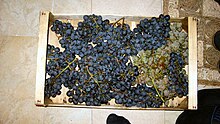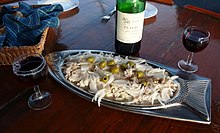Plavac Mali
| Plavac Mali | |
|---|---|
| Grape (Vitis) | |
 | |
| Color of berry skin | Red |
| Notable regions | Dalmatia, Croatia |
| Notable wines | Dingač, Postup |
| Ideal soil | Karst |
| VIVC number | 9549 |
| Wine characteristics | |
| Medium climate | Black cherry |
| Hot climate | Licorice, black pepper, cloves |
Plavac Mali (Croatian pronunciation: [plǎːʋat͡s mǎli]), a cross between Crljenak Kaštelanski (ancestral Zinfandel) and Dobričić grapes, is the primary red wine grape grown along the Dalmatian coast of Croatia.[1] The name refers to the small blue grapes that the vines produce: in Croatian plavo means blue; mali means small.
Plavac Mali is known for producing rich, flavorful wines that are high in both alcohol (typically 12% but up to 17%) and grape tannins.[1] Common flavors and aromas include blackberries, dark cherries, pepper, and spices. Croatian wines from this grape include the reds from Dingač and Postup on the Pelješac peninsula, Hvar island, Brač island, and the rosé Opol (a vinification style). The wines can be created as dry, such as Dingač and Postup, as well as semi-dry.
History[]

In the 1980s, Plavac Mali was incorrectly thought to be an ancestor of Zinfandel. In 1998, while researching the origins of Zinfandel through DNA fingerprinting, Dr. Carole Meredith at UC Davis with the urging from Mike Grgich (a well-known winemaker in Napa Valley originally from Croatia) and researchers from the University of Zagreb discovered that Zinfandel is actually one parent of Plavac Mali.[2] The other parent is an ancient variety known as Dobričić from the island of Šolta which, much like Crljenak Kaštelanski is not commonly found on its own.
References[]
- ^ a b Miquel Hudin (2012), Vinologue Dalmatia, Vinologue, p. 320, ISBN 978-0-615-23217-1
- ^ Meredith, Carole, "Looking for Zinfandel in Croatia", Zinfandel Express, January 2002.
External links[]
- "Explaining Plavac Mali", Hudin.com, January 14, 2011
- Grape varieties of Croatia
- Dalmatian grape varieties
- Red wine grape varieties
- Vis (island)